FIA75 Part 1: The Emergence of Farnborough (1948-1972)
September 2023 marked 75 years since the first airshow took place at Farnborough. To mark this anniversary, we invited local historian and aviation enthusiast, Peter Cooper, to help us look back at Farnborough’s history and recount some of his airshow experiences.
This blog looks at the first 25 years of the airshow and is the first of three in the series.
Read Part 2 here: FIA75 Part 2: Putting the International in FIA (1973-1997)
Read Part 3 here: FIA75 Part 3: Pioneering the Future (1998-2023)
Airshows Pre-Farnborough
The Society of British Aircraft Constructors (SBAC) was formed in 1916 and originally exhibited static aircraft at Olympia, London, later moving to RAF Hendon and then Hatfield to accommodate flying displays. These were halted during the Second World War but interest swiftly resumed once hostilities ceased.
The SBAC shows returned in 1946 and initially took place at the Handley Page Airfield at Radlett. 55 aircraft were on display from British aircraft manufacturers – many for the first time. Such had been the advancement of the British aviation industry during the war that this was seen as the largest aviation industry show to date. Growing pressure to extend the duration of the show and allow public admittance had SBAC in search of a more suitable, permanent home…
Farnborough – The Home of Pioneering Spirit
Farnborough presented SBAC with the perfect arena for their growing airshow. Not only is the area rich in aviation history, from housing the headquarters of the Royal Engineers Balloon School, the establishment of the Royal Aircraft Establishment (RAE) and Samuel Cody’s first powered flight to name a few, but it also ticked a lot of boxes on a technical level.
Farnborough had a natural show area both in the sky and on the ground, a large aircraft parking area and a longer runway, plus the fact that the infrastructure was better with good access to London by rail or road. Testimony to this is the fact that the shows are still held at Farnborough 75 years on.
Learn more about Farnborough’s Aviation History.
1948 & 1949 – The First Farnborough Airshows
The first Farnborough Airshow in 1948 featured sixty-six different British aircraft, many of which also participated in the flying display. There were many types seen for the first time and it would have been the sight of the ungainly, large helicopter with three rotors, the Cierva W.II Air Horse, that would have caught the eyes and ears of many. This helicopter was statically displayed for 1948 but took to the skies the following year.
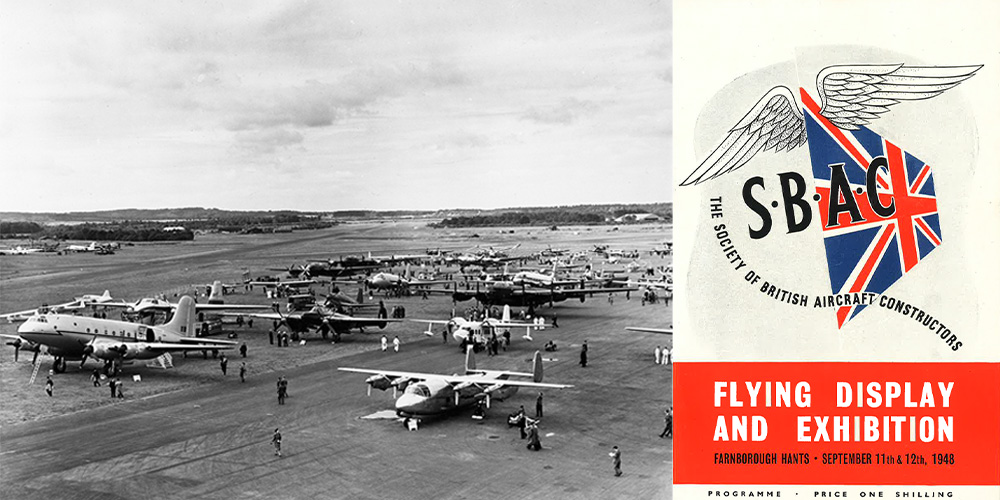
(The first show at Farnborough in 1948. There are some 40 aircraft seen here, with more to the right, being headed by two new Handley Page types, the Hastings C.1 and the Marathon — a good mixture of British types here. Image: FAST Archive)
In 1949, there were two truly iconic aircraft participating. Firstly, the world’s first jet airliner the de Havilland DH.106 Comet 1 and secondly, the mighty Bristol 167 Brabazon, the largest aircraft of its time that had only first flown four days before the show. The sleek lines of the Comet and sheer size of the Brabazon would leave many with lasting memories.

(The world's first jet airliner, the de Havilland DH.106 Comet I, as seen here at Farnborough on 6 September 1949, taxying for take-off on runway 25 to commence its flying display. The aircraft made its maiden flight on 27 July 1949 from Hatfield with John Cunningham at the controls. Image: FAST Archive)
1950s – Prototype Aircraft
By the early 1950s, Britain’s aircraft industry was vibrant with various prototype aircraft for both civil and military usage. The SBAC shows at that time had a plethora of different types with manufacturers all vying for important contracts with airlines or the Ministry of Defence. Of course, many of these prototype aircraft never made full-scale production, but to see them displayed was fascinating to behold. Those early years were incredibly important. My first recollection of Farnborough was in 1950 when my father pointed out the Brabazon flying over the airfield casting an aluminium cloud.
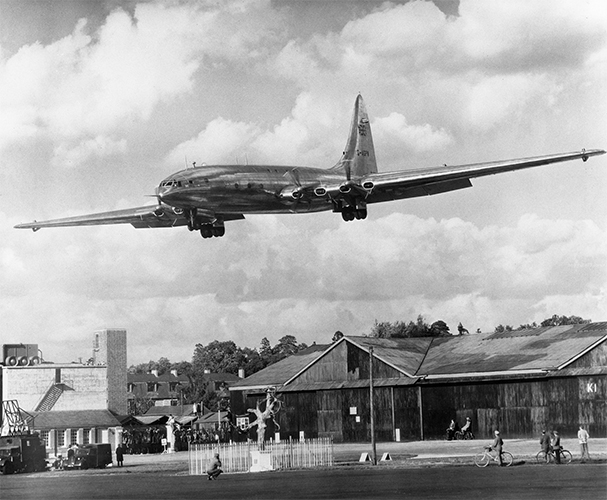
(The Bristol 167 Brabazon passes over the "Black Sheds" and Cody's Tree, as it makes its approach at Farnborough on 7 September 1950. Image: FAST Archive)
On 6 September 1952, a prototype de Havilland DH.110 jet fighter crashed during an aerial display at the airshow. The pilot John Derry and flight observer Anthony Richards were killed in the incident. Tragically, 29 spectators also died and 63 people were injured. Although many years have passed since this tragedy, the memory of all those who lost their lives that day will forever be in our thoughts.
1953 – Princess Flying Boat
When the show returned in 1953, the Saunders-Roe SR.45 Princess Flying Boat flew down the Farnborough runway with the accompanying noise of its ten Proteus engines.
The same year saw six delta shapes in the air together: four Avro 707s and two Avro 698 Vulcans. It was spectacles like this that sparked my interest in the history of Farnborough’s aircraft that is still present today.
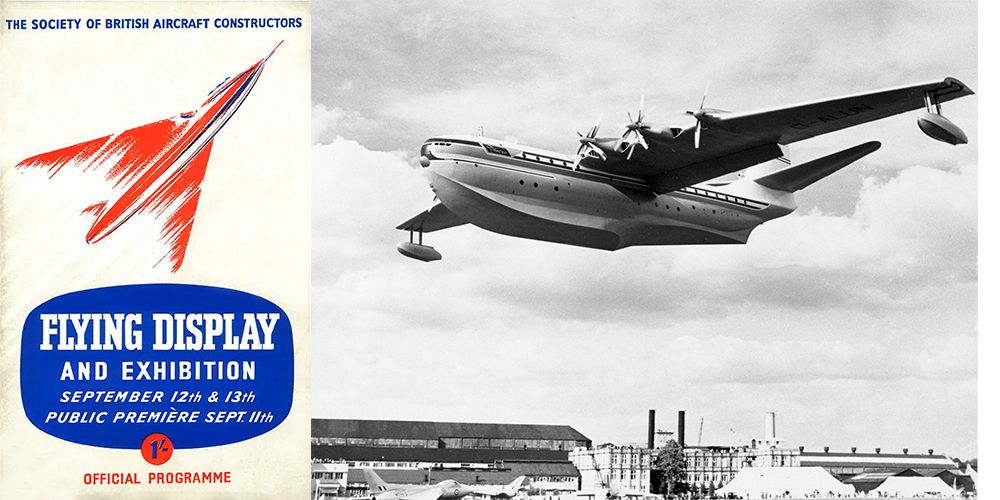
(The iconic Saunders-Roe SR.45 Princess Flying Boat makes a low pass along the Farnborough runway on 11 September 1953. This was the only example that flew, although two others were undergoing build when the project was cancelled. The noise emanating from the ten Bristol Proteus engines will never be forgotten. Image: FAST Archive)
1958 – World Record Loop
Aerobatic displays have performed at Farnborough right from the start. However, 1958 beat them all when 22 Hawker Hunter F.6s and a T.7 of the famed 111 Sqdn, The Black Arrows, looped in formation over the airfield, something that has never been done anywhere since. Now that was a considerable and remarkable achievement!
Watch the world record loop (jump to 12:30 to go straight to the 22 aircraft loop)
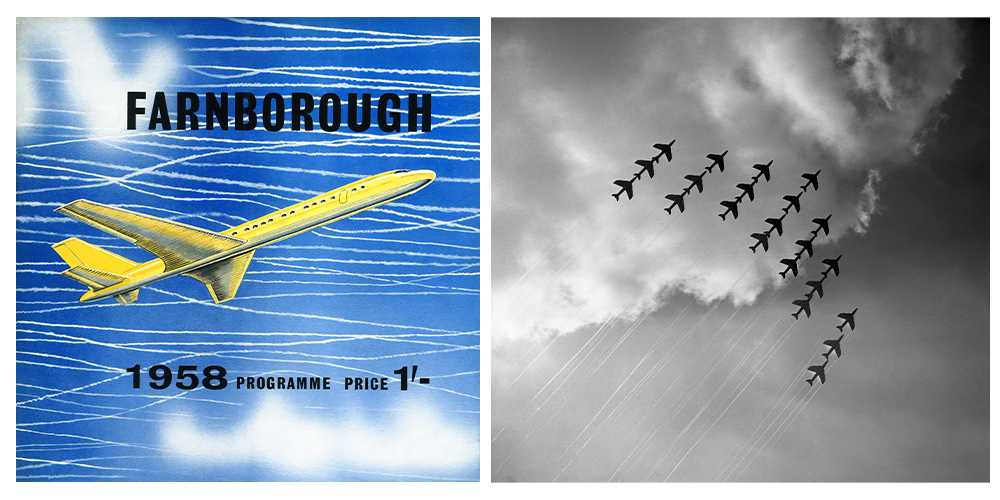
("The Black Arrows", 22 Hawker Hunter F.6s and a T.7 in perfect formation, seen here trailing wing tip vortices as they enter the top of the loop. Image: FAST Archive)
1960 – Defence Showcase
By 1960, the RAF V-bomber force had all three new bomber types in service: the Avro Vulcan, Handley Page Victor and Vickers Valiant. These aircraft were primarily in service to counter any Cold War threats and were built specifically as strategic bombers, including the carriage of nuclear weapons. At their home bases around England, they were on a 24-hour constant alert to any incoming threat. To promote this, the 1960 airshow saw demonstrations by four of each aircraft on alternating days, involving a quick scramble from the Farnborough runway to altitude in less than six minutes. That was some sight and sound to behold as they were put into take-off power with the ground shaking all around, let alone the pounding to the chest. No ear defenders then!

(Four Vickers Valiant BK.1s of 148 Sqdn in position on the Farnborough runway just prior to their "scramble" on 5 September 1960. The noise of these four aircraft at full power for take-off was quite deafening with accompanying chest vibrations. Image: John Rawlings Collection (FAST Archive))
1966 – Broadening Farnborough’s Horizon
Following the decision to hold the show biennially after 1964, by 1966 foreign aircraft participation was also allowed providing the aircraft had British equipment. This boosted the display and its content which featured ten foreign aircraft including the DHC-6 Twin Otter, Aermacchi MB.326, Fiat G91T, Breguet Atlantic and Transall C.160.
The nine EE Lightning F.2s of 92 Sqdn were most impressive with the customary stream take-off accompanied by noise and reheat flames. The “Yellowjacks” aerobatic team performed with five of their Folland Gnat T.1s, the forerunners of todays “Red Arrows” which performed the following year.
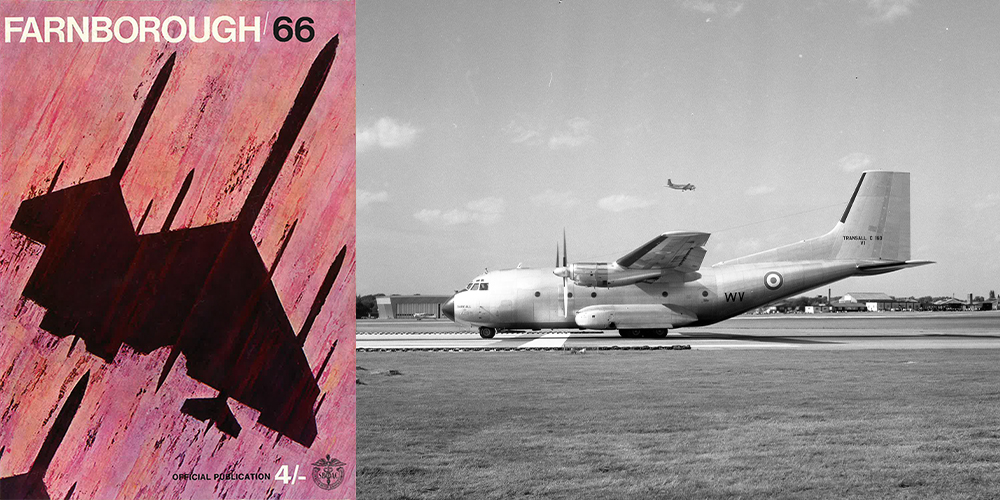
(Transall C160 Prototype, in natural metal, with French Air Force roundels, waits for clearance to commence its Farnborough debut display on 4 September 1966. The Breguet Atlantic can be seen on the downwind leg beyond. Image: John Rawlings Collection (FAST Archive))
1970 – Concorde’s debut
BAC-Aerospatiale Concorde made its triumphant Farnborough debut in 1970 with a low fly pass over spectators. The sight of this futuristic high-speed airliner provided the wow factor as it passed overhead, trailing smoke from all four engines. Early concepts of Concorde had been shared with exhibitors at Farnborough as early as 1962 and its displays became a fan favourite for many years to come.
Learn more about Concorde’s appearances at Farnborough.

(The BAC prototype Concorde G-BSST made its first Farnborough appearance in September 1970, flying from/to Fairford. It is seen here showing off its top side as it banks over Southwood. It made its first flight on 4 April 1969 and would later be seen on the ground at Farnborough in 1976. Image: Paul Cooper)
Farnborough’s First 25 Years
These were indeed ‘heady’ times for Farnborough as the airshows were full of surprises. Attendees never quite knew what they would see until the aircraft turned up! This period saw some incredible displays, many being flown at low level, and whilst the like will never be seen again, they will certainly not be forgotten.
The growth of foreign participation was to boost the aviation industry and consequently the airshow itself with a wide variety of aircraft types to behold. Indeed, even in the trade exhibition halls it was brisk business and the increasing diversity of exhibitors foreshadowed the growing international stage that awaited Farnborough in the coming decades.
Learn more about this development in the second part to this blog series, 'Putting the International in FIA'.
Do you have a favourite memory you’d like to share?
Get involved on our social media channels and tag Farnborough International Airshow in your posts so we can share your memories too!
Use the hashtags #FIA75 and #FIAmemories.